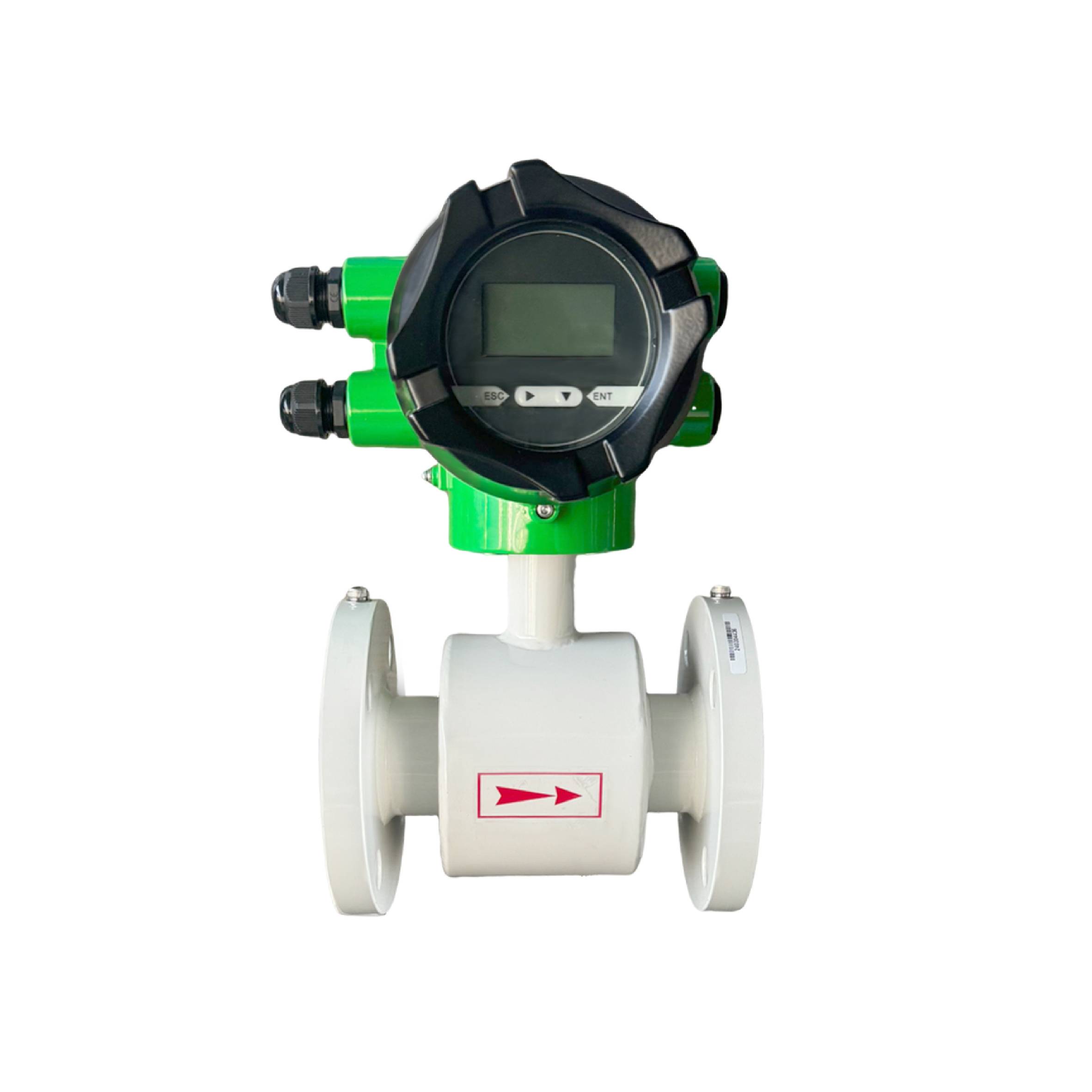In the field of fluid measurement in industrial production, electromagnetic flowmeters have been widely used due to their advantages such as high measurement accuracy, wide measurement range, and the ability to measure a variety of conductive liquids. However, in the actual use process, measurement error problems occur from time to time. This not only affects the precise control of the production process but may also lead to increased costs and a decline in product quality. This article will deeply explore the causes of measurement errors of electromagnetic flowmeters and provide targeted solutions.
I. Phenomena and Impacts of Measurement Errors
The measurement error of an electromagnetic flowmeter is manifested as the discrepancy between the displayed flow value and the actual fluid flow. This error can be a positive deviation, that is, the displayed value is greater than the actual value, or a negative deviation, where the displayed value is less than the actual value. In chemical production, the precise proportioning of various raw materials is of vital importance. If the electromagnetic flowmeter used to measure the flow of reaction raw materials has an error, it will lead to an imbalance in the raw material proportioning, affect the progress of the chemical reaction, and further reduce product quality. In severe cases, it may even cause production accidents. In the energy industry, such as the transportation and measurement of oil and natural gas, measurement errors will result in inaccurate trade settlement and trigger economic disputes.

II. Causes of Measurement Errors
Installation Problems
Insufficient Straight Pipe Sections: Electromagnetic flowmeters have strict requirements for the upstream and downstream straight pipe sections. Generally, the length of the upstream straight pipe section should be no less than 5 - 10 times the pipe diameter, and the length of the downstream straight pipe section should be no less than 3 - 5 times the pipe diameter. If the actual installed length of the straight pipe section is insufficient, the fluid flow state is unstable when entering the flowmeter, which will lead to measurement errors. For example, after a pipeline renovation in a certain factory, due to space limitations, the upstream straight pipe section of the electromagnetic flowmeter was only 2 times the pipe diameter. After it was put into use, the flow measurement error was as high as ±15%.
Improper Installation Location: If the electromagnetic flowmeter is installed at positions such as the bend of the pipeline, near the valve, or at the outlet of the pump, the fluid will generate turbulent flow, vortices, and other unstable flow states at these places, which will also affect the measurement accuracy. For instance, when the electromagnetic flowmeter is installed too close to an elbow, the change in the fluid direction and the uneven velocity distribution at the elbow make the signal measured by the flowmeter inaccurate.
Poor Grounding: Electromagnetic flowmeters require good grounding to eliminate the influence of external electromagnetic interference on the measurement signal. If the grounding resistance is too large or the grounding line has poor contact, it will cause fluctuations in the measurement signal and lead to measurement errors. In some industrial sites, due to non - standard grounding construction, the grounding end of the flowmeter is not reliably connected to the special grounding electrode as required but is casually connected to positions such as pipeline supports, resulting in poor grounding and affecting the measurement accuracy.
Changes in Fluid Characteristics
Abnormal Conductivity: Electromagnetic flowmeters operate based on Faraday's law of electromagnetic induction and require the measured fluid to have a certain conductivity. Generally, the fluid conductivity should be greater than 5μS/cm. When the fluid conductivity is too low, close to or below this critical value, the measurement signal will become weak, and the measurement error will increase. For example, in the pure water production process, if the ion content in the water is extremely low and the conductivity may only be 1 - 2μS/cm, when using an electromagnetic flowmeter to measure the water flow, the error will increase significantly. In addition, the inhomogeneity of the fluid conductivity will also affect the measurement accuracy. If there is stratification or local changes in the fluid conductivity in the pipeline, it will lead to unstable measurement signals and cause errors.
Fluid Containing Impurities or Bubbles: When the fluid contains solid impurities, it may wear the electrodes of the flowmeter, affecting the signal transmission between the electrodes and the fluid, thus leading to measurement errors. For example, in a sewage treatment plant, the sewage contains various particulate impurities. After long - term use, the electrode surface of the electromagnetic flowmeter will be worn, and the measurement accuracy will decrease. When there are bubbles in the fluid, the bubbles will interfere with the electromagnetic induction signal, causing fluctuations in the measured value and resulting in large errors. In some chemical production processes, due to the gas generated by the reaction mixing into the liquid or the gas entering the fluid during pipeline transportation, this situation may occur.
Malfunctions of the Instrument Itself
Electrode Malfunctions: The electrodes of an electromagnetic flowmeter are key components for measuring signals. The electrodes may deteriorate in performance due to corrosion, scaling, and other reasons. In the measurement of some corrosive fluids, such as the transportation of chemical raw materials like sulfuric acid and hydrochloric acid, the electrodes are easily corroded, and the surface becomes rough, affecting the electrical contact between the electrodes and the fluid, distorting the measurement signal, and causing errors. In addition, when the fluid contains viscous substances or impurities, the electrode surface will scale, covering the electrodes and hindering the normal signal transmission.
Converter Malfunctions: The converter is responsible for amplifying, processing, and converting the weak electrical signal detected by the electrodes into a flow display value. If the electronic components inside the converter malfunction, such as a change in the amplifier gain or damage to the analog - to - digital converter, it will lead to incorrect signal processing and, in turn, cause measurement errors. For example, if a capacitor element inside the converter ages, resulting in a decline in its filtering performance, interference noise will be mixed into the measurement signal, affecting the measurement accuracy.
III. Solutions to Measurement Errors
Optimizing Installation
Ensuring the Length of Straight Pipe Sections: When installing an electromagnetic flowmeter, strictly follow the requirements of the product manual to ensure the length of the upstream and downstream straight pipe sections. If the on - site space is limited and the standard length of the straight pipe section cannot be met, auxiliary devices such as flow straighteners can be considered to improve the fluid flow state. For example, in a certain pipeline installation, due to space limitations, the upstream straight pipe section could only reach 3 times the pipe diameter. After installing a suitable flow straightener, the measurement error was reduced from ±12% to within ±3%.
Selecting an Appropriate Installation Location: Install the electromagnetic flowmeter away from positions such as pipeline bends, valves, and pump outlets, and choose a straight pipe section with a stable fluid flow state for installation. When designing the pipeline layout, the installation requirements of the electromagnetic flowmeter should be fully considered to provide a good installation environment for it.
Standardizing Grounding: Set up a special grounding electrode for the electromagnetic flowmeter in accordance with the grounding specification requirements, and the grounding resistance should be less than 100Ω. Connect the grounding end of the flowmeter to the grounding electrode reliably through the grounding wire to ensure that the grounding line is firmly connected without looseness, oxidation, and other phenomena. In some industrial environments with strong electromagnetic interference, a multi - point grounding method can also be adopted to further improve the anti - interference ability.
Coping with Changes in Fluid Characteristics
Monitoring and Adjusting Conductivity: For fluids whose conductivity may change, install a conductivity monitor to monitor the fluid conductivity in real time. When the conductivity is lower than the specified value, methods such as adding electrolytes can be adopted to increase the fluid conductivity. For example, in pure water production, by adding an appropriate amount of electrolytes such as sodium chloride to the water, the conductivity can reach above 5μS/cm, ensuring the normal measurement of the electromagnetic flowmeter. For fluids with inhomogeneous conductivity, mixing devices such as static mixers can be used to make the conductivity in the fluid evenly distributed and reduce measurement errors.
Removing Impurities and Bubbles: Install a filter before the fluid enters the electromagnetic flowmeter to filter out the solid impurities in the fluid and protect the electrodes of the flowmeter from wear. For fluids prone to generating bubbles, an exhaust device can be used, such as installing an exhaust valve at the high point of the pipeline to discharge the bubbles in the fluid in a timely manner. In some chemical production processes, it is also possible to reduce the possibility of gas mixing into the liquid by optimizing the process flow.
Instrument Maintenance and Fault Repair
Regularly Inspecting the Electrodes: Regularly inspect the electrodes of the electromagnetic flowmeter and observe whether there are corrosion and scaling phenomena on the electrode surface. For corroded electrodes, replace or repair them in a timely manner. For scaled electrodes, chemical cleaning or mechanical cleaning methods can be used for treatment. When using chemical cleaning, select a suitable cleaning agent according to the nature of the fluid. For general dirt, a dilute hydrochloric acid solution can be used for cleaning; for mechanical cleaning, tools such as a soft brush can be used to gently brush the electrode surface.
Detecting and Repairing the Converter: Regularly detect the converter and use professional detection equipment to check the performance of its internal electronic components. If an electronic component malfunction is found, replace it in a timely manner. At the same time, upgrade and maintain the software of the converter to ensure that its algorithm and parameter settings are correct, so as to improve the measurement accuracy. In some intelligent electromagnetic flowmeters, the built - in diagnostic function can also be used to monitor the running status of the instrument in real time and discover and solve problems in a timely manner.


